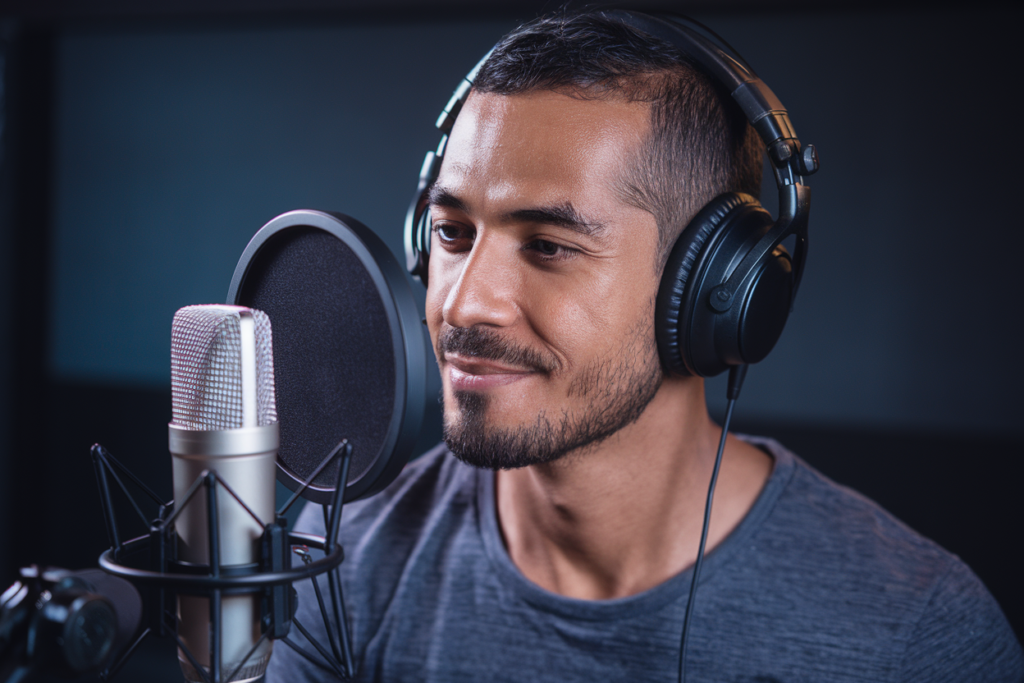Key Takeaways
- Importance of Standard Pronunciation: Clear and consistent pronunciation enhances audience comprehension and emotional connection in Arabic dubbing.
- Role of Voice Actors: Skilled voice actors are essential for capturing character essence and delivering engaging performances, making them pivotal to successful dubbing.
- Cultural Relevance: Employing standard pronunciation respects regional dialects, fostering a deeper connection with diverse Arabic-speaking audiences.
- Techniques for Clarity: Effective voice training methods and script adaptation strategies are crucial for achieving standard pronunciation in dubbing.
- Challenges in Dubbing: Regional dialect diversity and technological limitations pose significant challenges that require careful navigation to maintain quality.
- Future Trends: The future of Arabic dubbing is shaped by AI tools, increased demand for diverse talent, enhanced cultural nuance focus, interactive experiences, remote recording solutions, multimedia integration, and sustainability practices.
Ever wondered why some Arabic dubbed shows sound so much better than others? Standard pronunciation in Arabic dubbing plays a crucial role in bringing characters to life and ensuring your favorite series resonates with audiences. It’s not just about translating words; it’s about capturing the essence of the original dialogue.
Overview of Arabic Dubbing
Arabic dubbing plays a crucial role in making foreign content accessible to Arabic-speaking audiences. It transforms original dialogue into Arabic while preserving the emotional depth and cultural nuances of the characters. This process involves skilled voice actors who capture the essence of each character, ensuring that viewers connect with the story.
Standard pronunciation is vital in this context. When voice talent uses clear and consistent pronunciation, it enhances comprehension and creates an immersive experience for the audience. Effective dubbing requires not just translation but a deep understanding of both languages’ phonetics and rhythms.
Voice artists must possess strong skills in acting, as they need to convey emotions through their voices alone. The right choice of voice actor can significantly impact how well a character is received by audiences. A talented voice over artist brings life to animated films, TV shows, or commercials by embodying various personalities through vocal performance.
Moreover, consistency across different projects matters greatly in Arabic dubbing. Maintaining standard pronunciation ensures that familiar characters sound recognizable across various episodes or films. This consistency fosters trust and loyalty among fans who appreciate high-quality localization efforts.
Arabic dubbing relies on expert voice actors who uphold standard pronunciation while delivering engaging performances that resonate with viewers. Their contributions go beyond mere words—they create memorable experiences that bridge cultures and bring stories to life for audiences everywhere.
Importance of Standard Pronunciation
Standard pronunciation plays a vital role in Arabic dubbing, as it ensures clarity and consistency across various media. It helps portray characters authentically while maintaining the original intent of the dialogue.
Cultural Relevance
Cultural relevance significantly influences how audiences connect with content. When standard pronunciation is used, it respects regional dialects and cultural nuances, allowing viewers to feel more at home with the material. By employing skilled voice actors who understand these subtleties, you foster an atmosphere where stories resonate deeply. This connection not only enhances enjoyment but also strengthens cultural appreciation among diverse Arabic-speaking audiences.
Audience Engagement
Engaging your audience hinges on effective communication. Clear, consistent pronunciation by talented voice artists captures attention and keeps viewers invested in the narrative. When characters sound familiar and relatable, they become more memorable too. You want your audience to immerse themselves in the experience without being distracted by unclear speech or inconsistent voices across episodes or films. The right voice over talent brings energy and emotion that elevate storytelling, making every scene impactful for listeners.
Techniques for Achieving Standard Pronunciation
Achieving standard pronunciation in Arabic dubbing is crucial for effective communication and audience engagement. Here are some key techniques to ensure clarity and consistency.
Voice Training Methods
Voice training methods play a significant role in helping voice actors develop their skills. These methods include:
- Articulation exercises: Focus on improving the clarity of speech by practicing specific sounds and syllables.
- Breathing techniques: Teach control over breath support, allowing for longer phrases without losing breath quality.
- Pitch modulation: Encourage voice artists to explore different pitches to enhance expressiveness while maintaining standard pronunciation.
- Accent reduction: Help actors minimize regional accents that may distract from the intended message, ensuring a more neutral delivery.
Engaging with professional coaches can further refine these skills, providing personalized feedback that enhances overall performance.
Script Adaptation Strategies
Script adaptation strategies facilitate the integration of standard pronunciation into the dubbing process. Key strategies include:
- Phonetic transcription: Use phonetic spelling in scripts to guide voice actors on how words should be pronounced accurately.
- Contextual adjustments: Modify dialogue slightly to fit cultural nuances while preserving the essence of the original content, making it more relatable for audiences.
- Collaborative workshops: Conduct sessions where voice talent can work together, sharing insights on pronunciation challenges and best practices.
- Feedback loops: Establish mechanisms where directors provide ongoing feedback during recording sessions, ensuring that any mispronunciations are corrected promptly.
These strategies contribute significantly to creating an authentic experience for viewers through clear and engaging performances.
Challenges in Arabic Dubbing
Arabic dubbing faces several challenges that can impact the quality and coherence of the final product. Understanding these hurdles helps ensure effective localization while preserving cultural authenticity.
Regional Dialects
Arabic boasts a wealth of regional dialects, each with unique phonetic qualities and vocabulary. This diversity poses a challenge for voice actors aiming for standard pronunciation. When adapting content, striking a balance between clear communication and respect for local dialects becomes crucial. A generalized accent might alienate certain audiences, while overly localized pronunciations may hinder broader comprehension. Voice artists must navigate this linguistic landscape skillfully to connect with viewers across different regions.
Technological Limitations
Technological advancements have improved many aspects of dubbing, yet limitations persist. Software used for audio editing or synchronization might not always accommodate the nuances of Arabic speech patterns effectively. For instance, timing adjustments can affect emotional delivery if not handled carefully by the voiceover talent involved in the project. Additionally, sound quality can vary based on recording environments and equipment used during sessions. Strong collaboration between creative teams ensures that technological constraints do not compromise the integrity and clarity of performances delivered by voice over actors.
By addressing these challenges head-on, you enhance your projects’ potential to resonate powerfully with Arabic-speaking audiences while maintaining high standards in dubbing practices.
Future Trends in Arabic Dubbing
The landscape of Arabic dubbing is evolving rapidly, influenced by technological advancements and changing audience preferences. You can expect several emerging trends that will shape the future of this industry.
- Increased Use of AI Tools
AI tools are making their way into the dubbing process. These technologies can assist voice actors by providing real-time feedback on pronunciation and intonation, enhancing performance quality while saving time during production.
- Diversity in Voice Over Talent
The demand for diverse voice over talent continues to grow. Producers are increasingly seeking voice artists who represent various regional dialects and cultural backgrounds, ensuring authenticity in character portrayal and broadening audience appeal.
- Enhanced Focus on Cultural Nuance
As audiences become more discerning, there’s a heightened focus on capturing cultural nuances in dubbing. Voice actors must convey not just words but emotions tied to specific cultural contexts, enriching the viewer’s experience.
- Interactive Dubbing Experiences
Innovations in technology allow for interactive dubbing experiences where viewers can choose different versions of dialogue or characters’ voices. This personalization caters to individual preferences, making content more engaging.
- Remote Recording Solutions
The rise of remote recording technologies has shifted how voice actors work together with production teams. You’ll find that many projects now leverage online platforms for collaboration, which streamlines workflows and opens opportunities for talent regardless of location.
- Integration with Multimedia Platforms
As streaming services expand their offerings, there’s an increasing need for high-quality dubbing across multiple formats—films, series, games—ensuring consistent standards across all media types.
- Sustainability Practices
Sustainability is becoming a priority in film production processes, including dubbing practices. Efficient use of resources and environmentally friendly methods may soon define best practices within the industry.
These trends indicate a dynamic shift towards a more inclusive and technologically advanced approach to Arabic dubbing that prioritizes both quality and audience connection.
Conclusion
Standard pronunciation in Arabic dubbing is essential for creating an engaging and relatable viewing experience. By focusing on clear communication and emotional authenticity, you can help bridge cultural gaps and enhance audience connection.
As the industry evolves with new technologies and techniques, staying attuned to these changes will ensure that your dubbing efforts remain relevant and effective. Embracing collaboration among voice actors, scriptwriters, and sound engineers is vital for overcoming challenges while respecting regional dialects.
Ultimately, prioritizing standard pronunciation not only enriches storytelling but also fosters appreciation for diverse cultures within the Arabic-speaking community. Your commitment to high-quality dubbing practices will resonate with audiences long after they’ve finished watching.
Frequently Asked Questions
What is the importance of standard pronunciation in Arabic dubbing?
Standard pronunciation in Arabic dubbing enhances character portrayal and ensures that shows resonate with audiences. It captures the essence of original dialogue, making foreign content accessible while preserving emotional depth and cultural nuances.
How do voice actors contribute to effective Arabic dubbing?
Skilled voice actors convey emotions through clear and consistent pronunciation, which enhances comprehension and creates an immersive experience for viewers. Their performances help make characters relatable and memorable.
What techniques can voice actors use to achieve standard pronunciation?
Voice actors can use articulation exercises, breathing techniques, pitch modulation, and accent reduction. Engaging with professional coaches also helps refine these skills for better performance.
What challenges are faced in Arabic dubbing regarding pronunciation?
Challenges include the diversity of regional dialects, which complicates achieving a standard pronunciation while still respecting local variations. Additionally, technological limitations may affect emotional delivery during dubbing.
How is technology influencing future trends in Arabic dubbing?
Technology advances such as AI tools provide real-time feedback on pronunciation and intonation. There’s also a focus on interactive experiences and remote recording solutions to enhance quality and audience engagement in dubbing practices.
Why is cultural relevance important in Arabic dubbing?
Cultural relevance ensures that standard pronunciation respects regional dialects and nuances, allowing viewers to connect more deeply with the material. This connection fosters enjoyment and strengthens cultural appreciation among diverse audiences.







